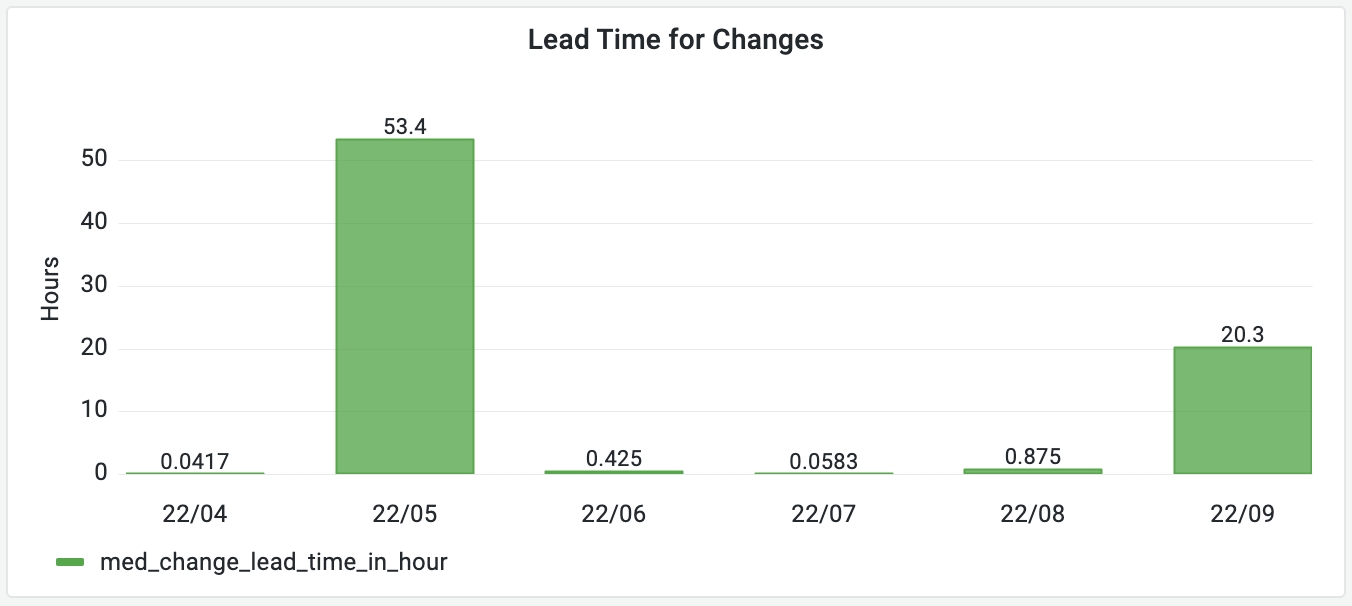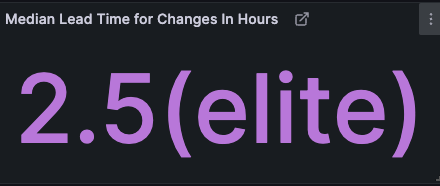DORA - Median Lead Time for Changes
What is this metric?
The median amount of time for a code change to be deployed into production.
Why is it important?
This metric measures the time it takes to a code change to the production environment and reflects the speed of software delivery. A lower average change preparation time means that your team is efficient at coding and deploying your project.
Which dashboard(s) does it exist in
DORA dashboard. See live demo.
How is it calculated?
This metric is quite similar to PR Cycle Time. The difference is that 'Lead Time for Changes' uses a different method to filter PRs.
- Find the PRs' associated deployment commits whose finished_date falls into the time range that users select.
- Find the associated pull requests of the commits diff between two consecutive successful
deployment commitsin the production environment. - Calculate the PRs' median cycle time. This will be the Median Lead Time for Changes.

PR cycle time is pre-calculated by the dora plugin during every data collection. You can find it in pr_cycle_time in table.project_pr_metrics of DevLake's database.
Below are the 2023 DORA benchmarks for different development teams from Google's report. However, it's difficult to tell which group a team falls into when the team's median lead time for changes is between one week and one month. Therefore, DevLake provides its own benchmarks to address this problem:
| Groups | Benchmarks | DevLake Benchmarks |
|---|---|---|
| Elite performers | Less than one day | Less than one day |
| High performers | Between one day and one week | Between one day and one week |
| Medium performers | Between one week and one month | Between one week and one month |
| Low performers | Between one week and one month | More than one month |
Source: 2023 Accelerate State of DevOps, Google
Click to expand or collapse 2021 DORA benchmarks
| Groups | Benchmarks | DevLake Benchmarks |
|---|---|---|
| Elite performers | Less than one hour | Less than one hour |
| High performers | Between one day and one week | Less than one week |
| Medium performers | Between one month and six months | Between one week and six months |
| Low performers | More than six months | More than six months |
Source: 2021 Accelerate State of DevOps, Google
Data Sources Required
Deploymentsfrom Jenkins, GitLab CI, GitHub Action, BitBucket Pipelines, Webhook, etc.Pull Requestsfrom GitHub PRs, GitLab MRs, BitBucket PRs, Azure DevOps PRs, etc.
Define deployment in data transformations while configuring the blueprint of a project to let DevLake know what CI records can be regarded as deployments.
If you want to measure the monthly trend of median lead time for changes as the picture shown below, run the following SQL in Grafana.

-- Metric 2: median change lead time per month
with _pr_stats as (
-- get the cycle time of PRs deployed by the deployments finished each month
SELECT
distinct pr.id,
date_format(cdc.finished_date,'%y/%m') as month,
ppm.pr_cycle_time
FROM
pull_requests pr
join project_pr_metrics ppm on ppm.id = pr.id
join project_mapping pm on pr.base_repo_id = pm.row_id and pm.`table` = 'repos'
join cicd_deployment_commits cdc on ppm.deployment_commit_id = cdc.id
WHERE
pm.project_name in (${project:sqlstring}+'')
and pr.merged_date is not null
and ppm.pr_cycle_time is not null
and $__timeFilter(cdc.finished_date)
),
_find_median_clt_each_month_ranks as(
SELECT *, percent_rank() over(PARTITION BY month order by pr_cycle_time) as ranks
FROM _pr_stats
),
_clt as(
SELECT month, max(pr_cycle_time) as median_change_lead_time
FROM _find_median_clt_each_month_ranks
WHERE ranks <= 0.5
group by month
)
SELECT
cm.month,
case
when _clt.median_change_lead_time is null then 0
else _clt.median_change_lead_time/60 end as median_change_lead_time_in_hour
FROM
calendar_months cm
LEFT JOIN _clt on cm.month = _clt.month
WHERE $__timeFilter(cm.month_timestamp)
If you want to measure in which category your team falls as in the picture shown below, run the following SQL in Grafana.

-- Metric 2: median lead time for changes
with _pr_stats as (
-- get the cycle time of PRs deployed by the deployments finished in the selected period
SELECT
distinct pr.id,
ppm.pr_cycle_time
FROM
pull_requests pr
join project_pr_metrics ppm on ppm.id = pr.id
join project_mapping pm on pr.base_repo_id = pm.row_id and pm.`table` = 'repos'
join cicd_deployment_commits cdc on ppm.deployment_commit_id = cdc.id
WHERE
pm.project_name in (${project})
and pr.merged_date is not null
and ppm.pr_cycle_time is not null
and $__timeFilter(cdc.finished_date)
),
_median_change_lead_time_ranks as(
SELECT *, percent_rank() over(order by pr_cycle_time) as ranks
FROM _pr_stats
),
_median_change_lead_time as(
-- use median PR cycle time as the median change lead time
SELECT max(pr_cycle_time) as median_change_lead_time
FROM _median_change_lead_time_ranks
WHERE ranks <= 0.5
)
SELECT
CASE
WHEN ('$dora_report') = '2023' THEN
CASE
WHEN median_change_lead_time < 24 * 60 THEN CONCAT(round(median_change_lead_time/60,1), "(elite)")
WHEN median_change_lead_time < 7 * 24 * 60 THEN CONCAT(round(median_change_lead_time/60,1), "(high)")
WHEN median_change_lead_time < 30 * 24 * 60 THEN CONCAT(round(median_change_lead_time/60,1), "(medium)")
WHEN median_change_lead_time >= 30 * 24 * 60 THEN CONCAT(round(median_change_lead_time/60,1), "(low)")
ELSE "N/A. Please check if you have collected deployments/pull_requests."
END
WHEN ('$dora_report') = '2021' THEN
CASE
WHEN median_change_lead_time < 60 THEN CONCAT(round(median_change_lead_time/60,1), "(elite)")
WHEN median_change_lead_time < 7 * 24 * 60 THEN CONCAT(round(median_change_lead_time/60,1), "(high)")
WHEN median_change_lead_time < 180 * 24 * 60 THEN CONCAT(round(median_change_lead_time/60,1), "(medium)")
WHEN median_change_lead_time >= 180 * 24 * 60 THEN CONCAT(round(median_change_lead_time/60,1), "(low)")
ELSE "N/A. Please check if you have collected deployments/pull_requests."
END
ELSE 'Invalid dora report'
END AS median_change_lead_time
FROM _median_change_lead_time
How to improve?
- Break requirements into smaller, more manageable deliverables
- Optimize the code review process
- "Shift left", start QA early and introduce more automated tests
- Integrate CI/CD tools to automate the deployment process